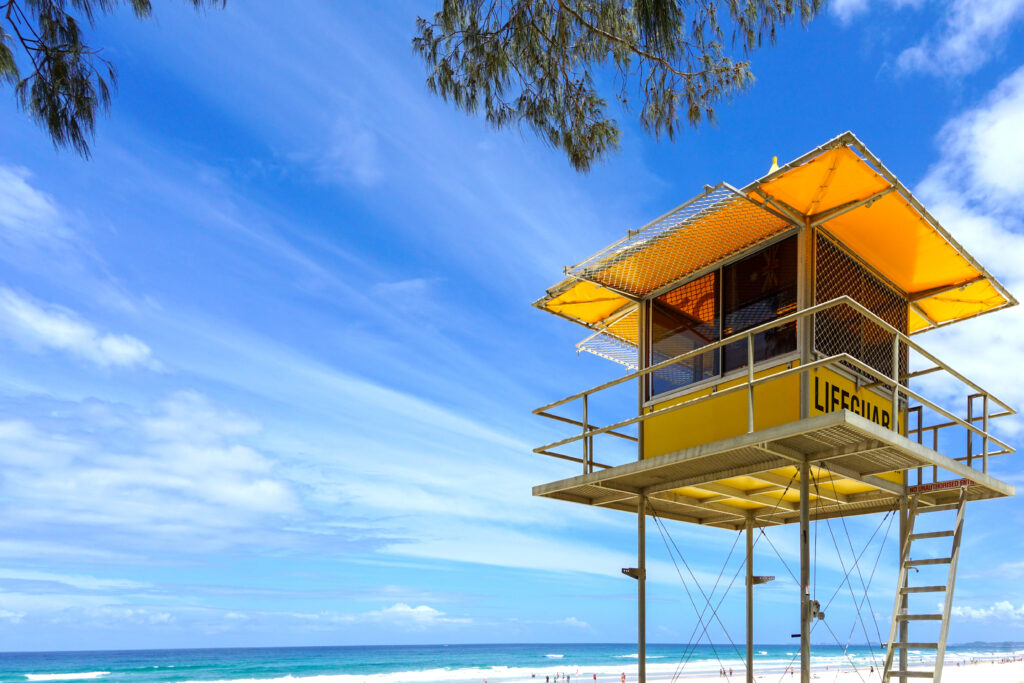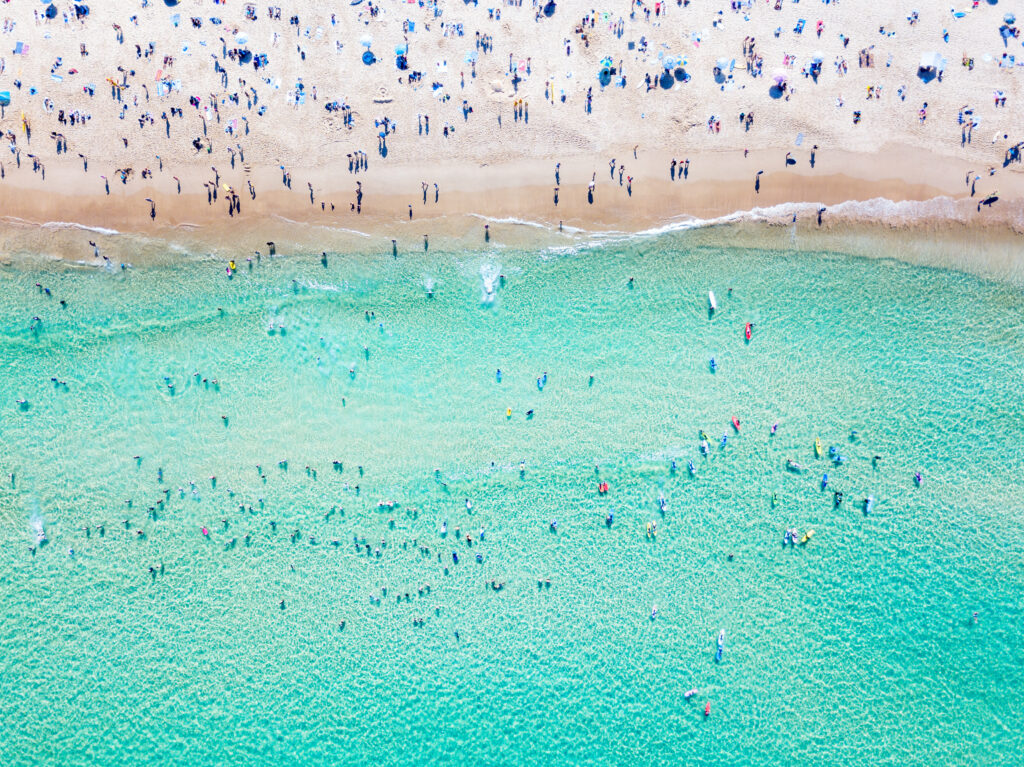Just arrived in Australia and keen to check out some of Australia’s famous beaches? A day at the beach with your friends is guaranteed to give you a good introduction to Aussie culture and be lots of fun – but sadly for some beachgoers, the fun can turn into tragedy. On average, 288 people drown in Australia each year, with around one in four people who drown being born overseas.
If you’re visiting the beach, you really need to understand beach safety in Australia so you don’t get caught up in an emergency.
In an emergency
If you suddenly find yourself in an emergency at the beach, there are a couple of things you can do:
- Raise your hand – If you’re stuck in the water and something has happened or you can’t safely swim back to shore, raising your hand signals to lifeguards that you or a friend need immediate help.
- Immediately alert a lifeguard or call Triple Zero (000) – If you’re onshore and see someone in distress, call for help immediately.

How can I swim safely?
Check the weather
Before heading out, it’s always a good idea to check the weather forecast. The official Australian Bureau of Meteorology website should give you a clear idea of the weather and surf conditions to expect on the day. Weather conditions have a huge impact on things like wave size, water currents, and the presence of bluebottles (which can sting) – so stay informed.
Choose the right beach for you
Some beaches are great for surfing, while others are calmer and more protected. Each beach has its own unique landscape and suitability for different swimmers. Make sure you check signs and do your research to find the best spot for you.
Never dive into the water without checking the depth. Some bodies of water can be deceptively shallow or deep – and beach landscapes are ever-changing. Never assume you know the beach well enough to dive in blindly. Also, keep an eye out for submerged objects or sand shelves.
Extra tips to stay safe
- Always swim at a patrolled beach. Seek a safe spot between the red and yellow flags.
- Swim with others. To stay safe, never swim at a beach when you’re completely alone.
- Swim during the daytime. Swimming at night or dusk may be risky.
Be sun safe – slip, slop, slap!
SLIP on a shirt, SLOP on some sunscreen and SLAP on a hat. To be sun-smart during an Australian Summer, remember to:
- Apply sunscreen
- Bring along a hat, shirt, and sunnies (an Australian way of saying ‘sunglasses’)
- Take a bottle of water to sip from
- Find a shady spot on the beach
Check the signs and swim between the flags
When you get to the beach, always look out for flags and signs – they’ll warn you about any potential hazards or dangerous conditions on the day (for example, common warnings will alert you to the presence of bluebottles or dangerous shore breaks).
The red and yellow flags are the most important signs on the beach – they mark the safest place to swim. The area between the red and yellow flags is actively patrolled by lifesavers. To stay safe, make sure you always swim between the flags.
Check out the Beach Safe website for a more detailed look at specific flags and signs.
Understand rip currents
A ‘rip’, or a rip current, is a powerful water current that flows away from the shore. It is often very hard to see on the surface of the water.
Rips are the number one hazard on Australian beaches – there are about 17,000 rips at Aussie beaches on any given day. They’re also dangerous – if you get caught in a rip, you might find yourself being very quickly pulled by a strong current out to sea.
The best way to avoid a rip is to swim at a patrolled beach between the red and yellow flags.
How to spot a rip current
Rips are complex, can quickly change their shape and location, and, at times, are difficult to see. You need to look for:
- Deeper, dark-coloured water
- Fewer breaking waves
- A rippled surface surrounded by smooth waters
- Anything floating out to sea or foamy, discoloured, sandy, water flowing out beyond the waves
Rips don’t always show all of these signs at once, so there might be one secretly lurking beneath the water!
Arabic | Simplified Chinese | Traditional Chinese | Hindi | Japanese | Korean | Malay
How to survive a rip current
- Relax – stay calm and float to conserve your energy
- Raise – raise your arm and attract attention from lifeguards or lifesavers
- Rescue– the lifeguards or lifesavers will be on their way to help you
- While you’re floating, rip currents may flow in a circular pattern and return you to an adjacent sandbar
- You may escape the rip current by swimming parallel to the beach, towards the breaking waves
- Reassess your situation. If what you’re doing isn’t working, try one of the other options until you’re rescued or return to shore
Remember, when it comes to staying safe, the best way to avoid being stuck in a rip current is to stay informed, be cautious, and avoid taking unnecessary risks.
Arabic | Simplified Chinese | Traditional Chinese | Hindi | Japanese | Korean | Malay
Get the Beachsafe App
Taking a road trip up the coast? Going on a seaside holiday? Or, are you just looking for the right beach for your swimming ability? Download the Beachsafe App and find the best beaches in seconds.
The app will allow you to instantly access the latest information about every Australian beach while you’re on the go. Offering unrivalled coverage of the Australian coastline, the app provides detailed information on everything from beach patrol status, facilities and hazards, to weather, swell and tide.
Download it from the App Store or Google Play.
Build your beach confidence
Learning to swim in a controlled, patrolled environment – like a local pool, or at the beach with your local swimming club – is a great way to develop confidence in and around the water. Joining a swimming club, surf club, group or team (or just hanging around by the local pool) is also a fantastic way to engage with your community and make local friends.
Surf clubs often run beachside club events, marathons and competitions, and community education programs teaching beach safety and swimming skills, which also foster a greater sense of local community. Many Aussie seaside suburbs have their own surf club, so if you’re keen to hit the water, don’t be shy – ask around! You can join, volunteer or (if you’re a strong swimmer) train to become a fully fledged lifesaver.
Follow these guidelines and you’ll be all set for a classic Aussie beach experience.





